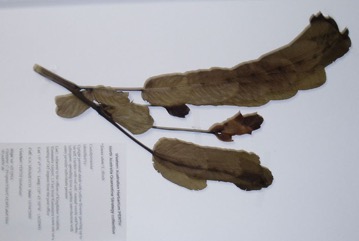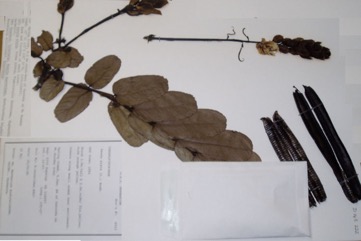Candle Bush, Ringworm Senna

A tropical plant. It prefers light to medium soils. It grows best in an open sunny position. It is drought and frost tender. It grows in rainforests and near swamps. It suits humid locations. It grows from 5 m to 360 m altitude in Papua New Guinea. In some countries it has been recorded up to 2,100 m above sea level. In Argentina it grows from sea level to 1,000 m above sea level. In Yunnan.
Also known as:
Anjananjana, Baba chakoda, Bhumiari, Bhupadma, Christmas candle, Chum het tet, Chum het yai, Cortalinde, Donghet, Empress candle plant, Gelenggang, Hpak-lam-mon-long, Hindi-sana, Kabaka, Katepeng badak, Ketepeng cina, Ketepeng, Khirkak, La'au fai lafa, Ludanggan, Mezali-gyi, Nat-ki-sana, Nela-tangedu, Nelavarike, Nila vaka, Nila virai, Pwesay-mezali, Ranauraa, Sanna-makki, Shona-makhi, Sindjo-el, Son-pat
Synonyms
- Cassia alata L.
- Cassia bracteata L.f.
- Cassia herpetica Jacq.
- Cassia rumphiana (DC.) Bojer
- Herpetica alata (L.) Raf.
Edible Portion
- Leaves, Seeds, Seeds - coffee, Flowers
Where does Candle Bush grow?
Found in: Africa, Amazon, American Samoa, Angola, Argentina, Asia, Australia, Benin, Bolivia, Brazil, Central Africa, Central America, Cambodia, China, Colombia, Congo DR, Cuba, Dominican Republic, East Africa, Gabon, Ghana, Grenada, Guiana, Guianas, Guinea, Guinée, Guinea-Bissau, Guyana, Haiti, India, Indochina, Indonesia, Jamaica, Lesser Antilles, Madagascar, Malawi, Malaysia, Maldives, Mali, Marquesas, Mexico, Micronesia, Myanmar, Nauru, Nicaragua, North America, Northeastern India, Pacific, Palau, Papua New Guinea, PNG, Paraguay, Puerto Rico, Rotuma, Samoa, Sao Tome and Principe, SE Asia, Sierra Leone, South America, Sri Lanka, St Lucia, Suriname, Thailand, United States, Venezuela, Vietnam, West Africa, West Indies
Notes: The leaves are used to treat ringworm. There are about 260 Senna species. It can be invasive. Also as Caesalpinaceae.
Status: It is not known if they are used for food in Papua New Guinea.
Growing Candle Bush, Ringworm Senna
Cultivation: Plants can be grown from seed.
Edible Uses: The young leaves and seeds have been recorded as eaten in Africa. The seeds are used as a coffee substitute. The flowers are cooked and eaten as a vegetable. Caution:
Nutrition Info
per 100g edible portion| Edible Part | Energy (kcal) | Protein (g) | Iron (mg) | Vitamin A (ug) | Vitamin c (mg) | Zinc (mg) | % Water |
|---|---|---|---|---|---|---|---|
| - | - | - | - | - | - |
Candle Bush, Ringworm Senna Photos


References
Achigan-Dako, E, et al (Eds), 2009, Catalogue of Traditional Vegetables in Benin. International Foundation for Science.
Ambasta S.P. (Ed.), 2000, The Useful Plants of India. CSIR India. p 109 (As Cassia alata)
Bodkin, F., 1991, Encyclopedia Botanica. Cornstalk publishing, p 220 (As Cassia alata)
Borrell, O.W., 1989, An Annotated Checklist of the Flora of Kairiru Island, New Guinea. Marcellin College, Victoria Australia. p 93, 100+8 (As Cassia alata)
Burkill, I.H., 1966, A Dictionary of the Economic Products of the Malay Peninsula. Ministry of Agriculture and Cooperatives, Kuala Lumpur, Malaysia. Vol 1 (A-H) p 479 (As Cassia alata)
Catarino, L., et al, 2016, Ecological data in support of an analysis of Guinea-Bissau's medicinal flora. Data in Brief 7 (2016):1078-1097
Cundall, P., (ed.), 2004, Gardening Australia: flora: the gardener's bible. ABC Books. p 1335
Dharani, N., 2002, Field Guide to common Trees & Shrubs of East Africa. Struik. p 264
Ekka, N. S. & Ekka, A., 2016, Wild Edible plants Used by Tribals of North-east Chhattisgarh (Part-I), India. Research Journal of Recent Sciences. Vol. 5(ISC-2015), 127-131 (2016) (As Cassia alata)
Fl. ind. ed. 1832, 2:349. 1832
Gardner, S., et al, 2000, A Field Guide to Forest Trees of Northern Thailand, Kobfai Publishing Project. p 172
Grandtner, M. M. & Chevrette, J., 2013, Dictionary of Trees, Volume 2: South America: Nomenclature, Taxonomy and Ecology. Academic Press p 597
Hall, N. et al, 1972, The Use of Trees and Shrubs in the Dry Country of Australia, AGPS, Canberra. p 208 (As Cassia alata)
Henty, E.E., & Pritchard, G.S., 1973, Weeds of New Guinea and their control. Botany Bulletin No 7, Division of Botany, Lae, PNG. p 116 (As Cassia alata)
Hibbert, M., 2002, The Aussie Plant Finder 2002, Florilegium. p 61 (As Cassia alata)
Jardin, C., 1970, List of Foods Used In Africa, FAO Nutrition Information Document Series No 2.p 25 (As Cassia alata)
Latham, P., 2004, Useful Plants of Bas-Congo province. Salvation Army & DFID p 70
Lazarides, M. & Hince, B., 1993, Handbook of Economic Plants of Australia, CSIRO. p 50 (As Cassia alata)
Marinelli, J. (Ed), 2004, Plant. DK. p 468
Martin, F.W. & Ruberte, R.M., 1979, Edible Leaves of the Tropics. Antillian College Press, Mayaguez, Puerto Rico. p 48, 198 (As Cassia alata and Herpetica alata)
Paczkowska, G. & Chapman, A.R., 2000, The Western Australian Flora. A Descriptive Catalogue. Western Australian Herbarium. p 190
Peekel, P.G., 1984, (Translation E.E.Henty), Flora of the Bismarck Archipelago for Naturalists, Division of Botany, Lae, PNG. p 219, 220 (As Cassia alata)
Pham-Hoang Ho, 1999, An Illustrated Flora of Vietnam. Nha Xuat Ban Tre. p 849 (As Cassia alata)
Plants of Haiti Smithsonian Institute http://botany.si.edu/antilles/West Indies
Sarma, H., et al, 2010, Updated Estimates of Wild Edible and Threatened Plants of Assam: A Meta-analysis. International Journal of Botany 6(4): 414-423 (As Cassia alata)
Staples, G.W. and Herbst, D.R., 2005, A tropical Garden Flora. Bishop Museum Press, Honolulu, Hawaii. p 325
Sujanapal, P., & Sankaran, K. V., 2016, Common Plants of Maldives. FAO & Kerala FRI, p 235
Sukarya, D. G., (Ed.) 2013, 3,500 Plant Species of the Botanic Gardens of Indonesia. LIPI p 712
Suksri, S., et al, 2005, Ethnobotany in Bung Khong Long Non-Hunting Area, Northeast Thailand. Kasetsart J., (Nat. Sci) 39: 519-533
Terashima, H., et al, 1992, Ethnobotany of the Lega in the Tropical Rainforest of Eastern Zaire (Congo): Part Two, Zone de Walikale, African Study Monographs, Suppl. 19:1-60
Turreira Garcia, N., et al, 2017, Ethnobotanical knowledgeof the Kuy and Khmer people in Prey Lang, Cambodia. Cambodian Journal of Natural History 2017 (1): 76-101 Verdcourt, B., 1979, Manual of New Guinea Legumes. Botany Bulletin No 11, Division of Botany, Lae, Papua New Guinea. p 38 (As Cassia alata)
World Checklist of Useful Plant Species 2020. Royal Botanic Gardens, Kew